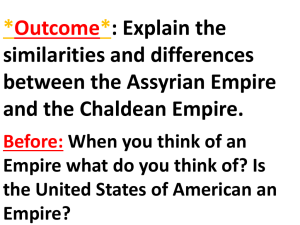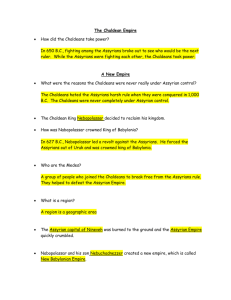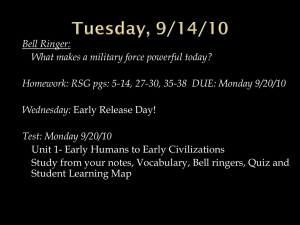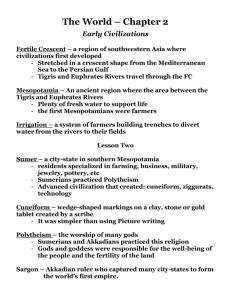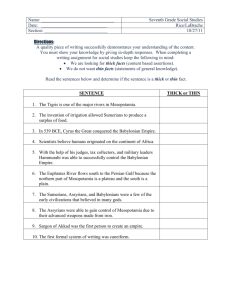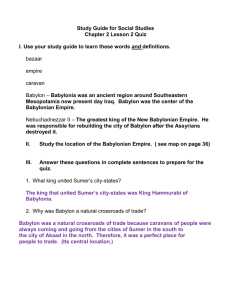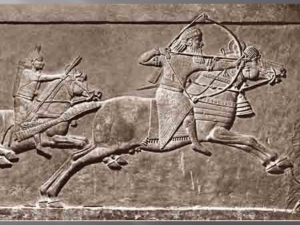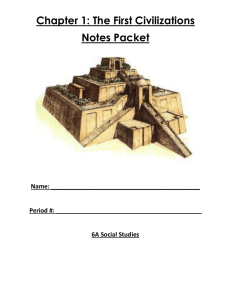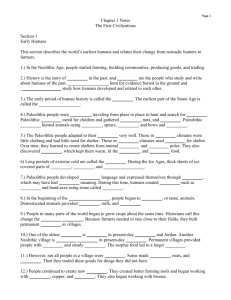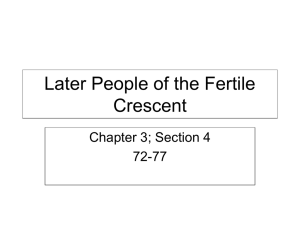chapter 1 section 3
advertisement
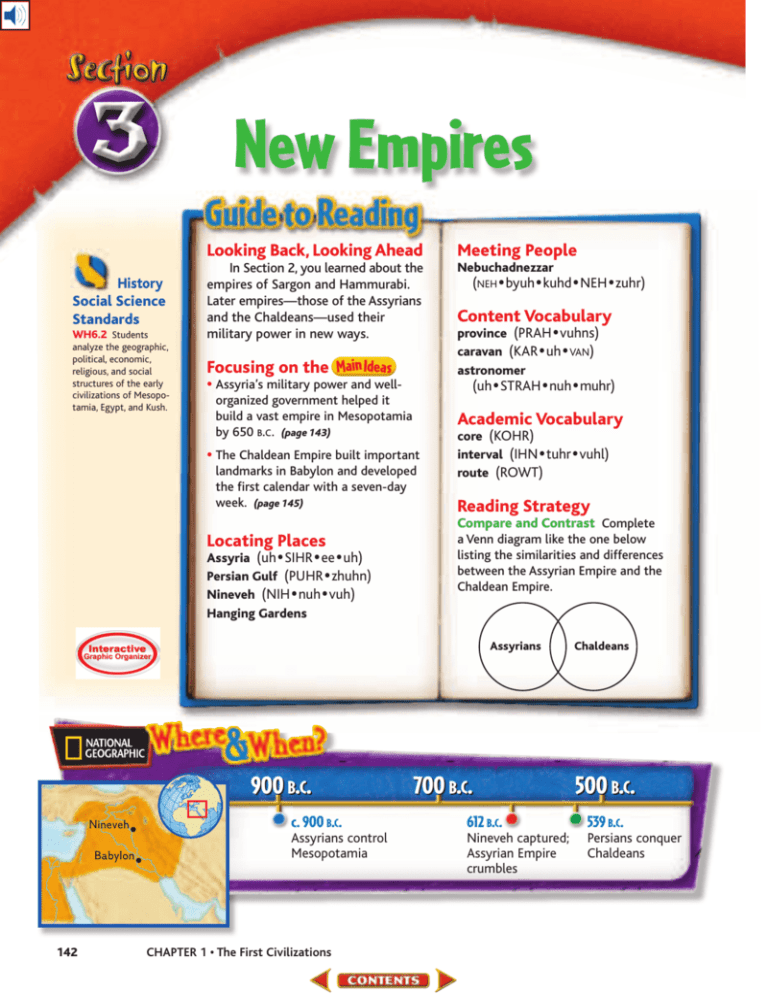
New Empires History Social Science Standards WH6.2 Students analyze the geographic, political, economic, religious, and social structures of the early civilizations of Mesopotamia, Egypt, and Kush. Looking Back, Looking Ahead Meeting People In Section 2, you learned about the empires of Sargon and Hammurabi. Later empires—those of the Assyrians and the Chaldeans—used their military power in new ways. Nebuchadnezzar Focusing on the • Assyria’s military power and well- province (PRAH • vuhns) caravan (KAR • uh • VAN) astronomer Academic Vocabulary • The Chaldean Empire built important landmarks in Babylon and developed the first calendar with a seven-day week. (page 145) Assyria (uh • SIHR • ee • uh) Persian Gulf (PUHR • zhuhn) Nineveh (NIH • nuh • vuh) Hanging Gardens Content Vocabulary (uh • STRAH • nuh • muhr) organized government helped it build a vast empire in Mesopotamia by 650 B.C. (page 143) Locating Places (NEH • byuh • kuhd • NEH • zuhr) core (KOHR) interval (IHN • tuhr • vuhl) route (ROWT) Reading Strategy Compare and Contrast Complete a Venn diagram like the one below listing the similarities and differences between the Assyrian Empire and the Chaldean Empire. Assyrians 900 B.C. Nineveh Babylon 142 700 B.C. Chaldeans 500 B.C. c. 900 B.C. 612 B.C. 539 B.C. Assyrians control Mesopotamia Nineveh captured; Assyrian Empire crumbles Persians conquer Chaldeans CHAPTER 1 • The First Civilizations WH6.2 Students analyze the geographic, political, economic, religious, and social structures of the early civilizations of Mesopotamia, Egypt, and Kush. The Assyrians Assyria’s military power and wellorganized government helped it build a vast empire in Mesopotamia by 650 B.C. Reading Connection Today, many countries have armed forces to protect their interests. Read to discover how the Assyrians built an army strong enough to conquer all of Mesopotamia. About 1,000 years after Hammurabi, a new empire arose in Mesopotamia. It was founded by a people called the Assyrians (uh • SIHR • ee • uhns), who lived in the north near the Tigris River. Assyria (uh • SIHR • ee • uh) had fertile valleys that attracted outside invaders. To defend their land, the Assyrians built a large army. Around 900 B.C., they began taking over the rest of Mesopotamia. Why Were the Assyrians So Strong? The Assyrian military was well organized. At its core were groups of foot soldiers armed with spears and daggers. Other soldiers were experts at using bows and arrows. The army also had chariot riders and soldiers who fought on horseback. This fearsome and mighty force was the first large army to use iron weapons. For centuries, iron had been used for tools, but it was too soft to serve as a material for weapons. Then a people called the Hittites (HIH • TYTZ), who lived northwest of Assyria, developed a way of making iron stronger. They heated iron ore, hammered it, and rapidly cooled it. The Assyrians learned this technique from the Hittites. They produced iron weapons that were stronger than those made of copper or tin. The Assyrians at War When attacking a walled city, the Assyrians used massive war machines. The wheeled battering ram was powered by soldiers. It was covered to protect the soldiers inside, but it had slits so they could shoot arrows out. What other methods did Assyrian soldiers use to attack cities? Assyrian Empire 300 mi. 0 40°N Assyrian winged bull statues stood as guardians at city gates. 40°E 300 km 0 Lambert Azimuthal Equal-Area projection ASIA MINOR s R . ri s at e Jerusalem Ti g hr A Tyre Nineveh MI TA PO SO Eup Mediterranean Sea M E R. Babylon EGYPT E S R. W Nile N Thebes ARABIAN DESERT Red Sea KEY Assyrian Empire 1. Location What major rivers were part of the Assyrian Empire? 2. Human/Environment Ineraction What geographical features may have kept the Assyrians from expanding their empire to the north and south? The Assyrians were ferocious warriors. To attack cities, they tunneled under walls or climbed over them on ladders. They loaded tree trunks onto movable platforms and used them as battering rams to knock down city gates. Once a city was captured, the Assyrians set fire to its buildings. They also carried away its people and goods. Anyone who resisted Assyrian rule was punished. The Assyrians drove people from their lands and moved them into foreign territory. Then they brought in new settlers and forced them to pay heavy taxes. A Well-Organized Government Assyrian kings had to be strong to rule their large empire. By about 650 B.C., the empire stretched from the Persian Gulf (PUHR • zhuhn) in the east to Egypt’s Nile River in the west. The capital was at Nineveh (NIH • nuh • vuh) on the Tigris River. 144 Boltin Picture Library CHAPTER 1 • The First Civilizations Assyrian kings divided the empire into provinces (PRAH • vuhn • suhs), or political districts. They chose officials to govern each province. The job of these officials was to collect taxes and enforce the king’s laws. Assyrian kings built roads to join all parts of their empire. Government soldiers were posted at stations along the way to protect traders from bandits. Messengers on government business used the stations to rest and change horses. Life in Assyria The Assyrians lived much like other Mesopotamians. Their writing was based on Babylonian writing, and they worshiped many of the same gods. Their laws were similar, but lawbreakers often faced more brutal and cruel punishments in Assyria. As builders, the Assyrians showed great skill. They erected large temples and palaces that they filled with wall carvings and statues. The Assyrians also produced and collected literature. One of the world’s first libraries was in Nineveh. It held 25,000 tablets of stories and songs to the gods. Modern historians have learned much about ancient civilizations from this library. Explain Why were the Assyrian soldiers considered brutal and cruel? Gianni Dagli Orti/CORBIS WH6.2 Students analyze the geographic, political, economic, religious, and social structures of the early civilizations of Mesopotamia, Egypt, and Kush. The Chaldeans The Chaldean Empire built important landmarks in Babylon and developed the first calendar with a seven-day week. Reading Connection What landmarks exist in your town or the nearest city? Read to learn some of the special landmarks that made the Chaldean capital of Babylon famous. Assyria’s cruel treatment of people led to many rebellions. About 650 B.C., the Assyrians began fighting each other over who would be their next king. Because the Assyrians were not united, a group of people called the Chaldeans (kahl • DEE • uhns) were able to rebel. The Chaldean people had moved from the Arabian Peninsula into southern Mesopotamia about 1000 B.C. Their small kingdom was quickly conquered by the Assyrians but the Chaldeans hated their new rulers. With the Assyrians busy fighting each other, King Nabopolasar of the Hanging Gardens The Hanging Gardens of Babylon were considered one of the Seven Wonders of the Ancient World. A complex irrigation system brought water from the Euphrates River to the top of the gardens. From there, the water flowed down to each of the lower levels of the gardens. What other sights made Babylon a grand city? Ruins of the Hanging Gardens Chaldeans decided the time had come to fight back. In 627 B.C. Nabopolasar led his people in rebellion against the Assyrians. The Chaldeans joined with the Medes, another people in the region who wanted to break free from the Assyrians. Together the Chaldeans and Medes defeated Assyria’s army. In 612 B.C. they captured the Assyrian capital of Nineveh and finally put an end to the hated Assyrian empire. Nabapolasar and his son, the famous King Nebuchadnezzar (NEH • byuh • khud • NEH • zuhr), then went on to build their own empire. By 605 B.C., the Chaldeans had Web Activity Visit ca.hss.glencoe.com and click on Chapter 1—Student Web Activity to learn more about the first civilizations. conquered nearly all of the lands the Assyrians had ruled. They made Babylon the capital of their empire, and because of this, the Chaldean Empire is sometimes called the New Babylonian Empire. These terraced gardens showcased large trees, masses of flowering vines, and other beautiful plants. A pump brought in water from a nearby river. Nebuchadnezzar built the gardens to please his wife, who missed the mountains and plants of her homeland in the northwest. One Greek historian in the 400s B.C. described the beauty of Babylon. He wrote, “In magnificence, there is no other city that approaches it.” Outside the center of Babylon stood houses and marketplaces. There, artisans made pottery, cloth, baskets, and jewelry. They sold their wares to passing caravans (KAR • uh • VANZ), or groups of traveling merchants. Because Babylon was located on the major trade route between the Persian Gulf and the Mediterranean Sea, it became rich from trade. The City of Babylon The Chaldeans rebuilt the city of Babylon as the glorious center of their empire. The city became the world’s largest and richest city. It was surrounded by a brick wall so wide that two chariots could pass on the road on top of it. Built into the wall at 100-yard (91.4-m) intervals were towers where soldiers kept watch. Large palaces and temples stood in the city’s center. A huge ziggurat reached more than 300 feet (91.4 m) into the sky. Another marvel, visible from any point in Babylon, was an immense staircase of greenery: the Hanging Gardens at the king’s palace. Chaldean Empire c. 605 B.C. KEY 200 km 0 Lambert Azimuthal Equal-Area projection Original Chaldean settlement Farthest extent of Chaldean Empire ASSYRIA M ES Nineveh OP E S R. ph W ris Eu MEDES Tig Damascus IA Tyre SYRIA AM Byblos Caspian Sea N OT Mediterranean Sea 40°N 200 mi. 0 40°E r at JUDAH 30°E Jerusalem ARABIAN DESERT es R. PERSIANS Babylon Susa EGYPT CHALDEANS 1. Location How far apart are the cities of Susa and Damascus? 2. Region How were the geographical locations of the original Chaldean settlement and Judah similar? 146 S. Fiore/SuperStock CHAPTER 1 • The First Civilizations 35°N Persian Gulf 50°E Babylon was also a center of science. Like earlier people in Mesopotamia, the Chaldeans believed that changes in the sky revealed the plans of the gods. Their astronomers (uh • STRAH • nuh • muhrs)—people who study the heavenly bodies— mapped the stars, the planets, and the phases of the moon. The Chaldeans made one of the first sundials and were the first to develop a seven-day week. Why Did the Empire Fall? A number of weak leaders, along with poor harvests and decreased trade, caused the Chaldeans to lose their power. In 539 B.C. Persians from the northeast captured Babylon and made Mesopotamia part of the new Persian Empire. The Ishtar Gate was at the main entrance to ancient Babylon. Describe the wall that surrounded Babylon. Identify What were the Hanging Gardens of Babylon? Study Central Need help understanding the Assyrians and Chaldeans? Visit ca.hss.glencoe.com and click on Study Central. Reading Summary Review the • Using cavalry and foot soldiers armed with iron weapons, the Assyrians created a large empire that included all of Mesopotamia and extended into Egypt. • The Chaldeans built a large empire in Mesopotamia that included Babylon, the largest and richest city in the world at that time. What Did You Learn? 1. Why was the Assyrian army a powerful fighting force? 5. 2. What were some of the accomplishments of Chaldean astronomers? Critical Thinking 3. Summarize Information Draw a chart like the one below. Use it to describe the city of Babylon and why it became powerful. CA HI2. Babylon Under Chaldeans 6. Explain Why did the Chaldeans join with the Medes to fight the Assyrians? CA HI1. 7. Science Link What different types of knowledge and skills would the Babylonians need to build the Hanging Gardens? CA 6RC2.3 8. 4. Analyze How did the Assyrians set up a wellorganized government? CA 6RC2.0 Why do you think the Assyrians took conquered peoples from their lands and moved them to other places? CA CS3. Posing Questions Write four questions about the Chaldeans you would like answered. Use the library and Internet to research and write answers to your questions. CA HR1. CHAPTER 1 • The First Civilizations 147 WH6.2.9 Trace the evolution of language and its written forms. Ancient Forms of Communication Sculpture of chariot from Mesopotamia Long before the rise of civilization, early people expressed themselves through paintings. People may have used these images to explain the universe. Later, people in Mesopotamia began using writing not only to express their ideas, but also to record important events and tell stories. These include epic stories of heroes, proverbs about how to live properly, and law codes. Study the painting and the passages that follow, and then answer the questions on page 149. Reader’s Dictionary old ones: the elders or leaders of the city Cave Painting One of the earliest forms of communication was through art. Beginning around 30,000 B.C., people began to crush rocks to make powder for painting on cave walls. The images they painted include animals, hunting scenes, and people engaged in various activities. These paintings may have had a religious meaning or may have been intended to record events. This cave painting is in Lascaux, France. The cave is filled with images drawn or carved by people during the Paleolithic Age, about 15,000 years ago. The images show animals and people, and tell stories about Paleolithic life. 148 CHAPTER 1 • The First Civilizations Enkidu (ehn • KEE • doo): Gilgamesh’s friend and traveling companion Advice for Gilgamesh The Code of Hammurabi The Epic of Gilgamesh is a legend about the The following is law seven from the Code of travels of Gilgamesh, king of Uruk in Babylonia. It was written about 2000 B.C. In the following passage, Gilgamesh is warned about going on a dangerous adventure alone. The old ones shaped their mouths and spoke, saying to Gilgamesh, “Do not trust all that strength of yours, Gilgamesh. Make sure your eyes are wide, your blow certain. Hammurabi. He ruled Babylon from around 1792 B.C. to 1750 B.C. 7. If any one buy from the son or the slave of another man, without witnesses or a contract, silver or gold, a male or female slave, an ox or a sheep, an ass or anything, or if he take it in charge, he is considered a thief and shall be put to death. —“Code of Hammurabi,” L. W. King, trans. The one who walks in front guards his friend; the one who knows the way safeguards his companion. Let Enkidu go before you as you march; he knows the way of the forest, to the cedars. He has seen battle, understands warfare. Enkidu will watch over the friend, make the way safe for his companion.” —Gilgamesh, John Gardner and John Maier, trans. Stone monument showing Hammurabi (standing) Cave Painting 1. What kind of animals are shown? 2. Why do you think this image was painted? The Epic of Gilgamesh 3. What do the old ones tell Gilgamesh to do instead of relying on his strength? Why? 4. Why do the old ones think it is a good idea for Enkidu to accompany Gilgamesh? The Code of Hammurabi 5. What is the punishment for making a deal without a witness or a contract? 6. Do you think the punishment would be the same if there were a witness or a contract? Why? Read to Write 7. How do you think the author of the Epic of Gilgamesh would have used words to express the image of the cave painting? 8. Based on the primary sources, explain what values you think were important to people in ancient Mesopotamia. How do these values compare to ours today? CA HI2.; HR4. CHAPTER 1 • The First Civilizations 149 Scala/Art Resource, NY Standards WH6.1 & WH6.2 Review Content Vocabulary 1. Write a brief paragraph that describes and compares the following terms. archaeologist artifact fossil 14. Describe What rights did women have in the city-states of Sumer? CA 6RC2.0 15. Predict How successful do you think the Assyrian army would have been if it had not learned how to strengthen iron? CA HI4. anthropologist Indicate which of the following statements are true. Replace the word in italics to make any false statements true. ___ 2. An artisan kept records in cuneiform. ___ 3. Assyrian kings divided their empire into political districts called provinces. ___ 4. A civilization is a group of many different lands under one ruler. Review the Section 1 • Early Humans 5. How did Paleolithic people adapt to their environment? 6. What were the major differences between people who lived in the Paleolithic period and those who lived in the Neolithic period? Geography Skills Study the map below and answer the following questions. 16. Location On what continent was the earliest fossil evidence of humans found? CA CS3. 17. Movement Based on fossil evidence, where did early humans go first, Europe or Australia? CA CS3. 18. Analyze Which three continents are not shown on this map? How do you think early humans reached those continents? CA CS3. Spread of Early Humans Section 2 • Mesopotamian Civilization 7. Where were the first civilizations in Mesopotamia? 8. What kinds of contributions did Sumerians make? 9. How did Sumerian city-states lose power? 30°E 60°N Critical Thinking 12. Explain Why do you think Mesopotamia is sometimes called the “cradle of civilization”? CA 6RC2.3 13. Analyze Why was the development of farming called a revolution? CA HI3. 150 CHAPTER 1 • The First Civilizations 150°E 25,000 years ago 40,000 years ago ASIA EUROPE Section 3 • New Empires 10. What helped Assyria build an empire in Mesopotamia? 11. What scientific advancement did the Chaldeans make? 90°E 100,000 years ago 30°N AFRICA 0° 150,000–200,000 years ago EQUATOR 50,000 years ago AUSTRALIA 30°S N 0 2,000 mi. E W 2,000 km 0 Mercator projection S KEY Movement of early humans Read to Write 19. Expository Writing Most of what we know about early humans comes from scientific discoveries. Write two to three paragraphs explaining how these scientists help historians gather information about the past. CA 6WA2.2 20. Using Your Use your Chapter 1 foldable to create an illustrated time line. Your time line should extend from the date Jericho was founded to the fall of the Chaldean Empire. Create drawings or photocopy maps, artifacts, or architecture to illustrate your time line. CA 6WS1.3 Using Academic Vocabulary Self-Check Quiz To help you prepare for the Chapter Test, visit ca.hss.glencoe.com 25. Researching Many important scientific discoveries, such as Lucy in 1974, changed the way that scientists understand early human history. Use your local library to research the discovery by anthropologist Tim White in 1992. What kind of new information did this discovery provide about early hominids? Write a research paper describing the importance of this discovery. CA HI5. 21. Use the words listed below as you write a two- to three-paragraph summary of Chapter 1. Make sure that you cover all of the important events and cultures that appear in the chapter. CA HI1. task revolution complex consist code core interval route Economics Connection 22. Persuasive Writing Suppose you are a merchant in Çatal Hüyük. A new group of people wants to trade with your village. Write a short speech to persuade your village that there are economic benefits to trading with other people. CA HI6. Linking Past and Present 23. Analyzing Information Imagine you are a nomad who travels from place to place to hunt and gather food. What things would you carry with you to help you survive? Make a list of items and discuss it with your classmates. CA 6RC2.4 Reviewing Skills 24. Previewing Imagine that a friend has to read Section 3. Write a few paragraphs telling him or her how to preview the section. CA 6RC2.4 Select the best answer for each of the following questions. 26 Which of these was a purpose of the ziggurat in ancient Mesopotamia? A B C D weapon storage schoolhouse office for recording votes the city’s treasury 27 The importance of ancient poems such as the Epic of Gilgamesh is that they continue to provide people with A historically accurate descriptions of events. B fantastic adventures with great heroes. C a deeper understanding of future events. D stories about real, historic people. CHAPTER 1 • The First Civilizations 151
